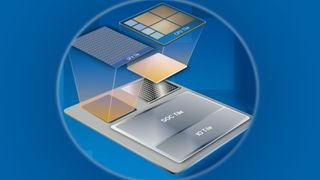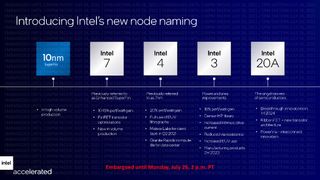Intel's Meteor Lake CPUs for Desktops Incoming, but There's a Catch
Mainstream parts at up to 65W

Intel is on track to release its codenamed Meteor Lake-S processors for desktops in the coming quarters, but there's a catch. The company will only address entry-level and mainstream systems with these CPUs, whereas performance-demanding PCs will have to use Raptor Lake Refresh or Arrow Lake-S processors.
It looks as though Intel's Meteor Lake-S processors will only exist in Core i3 and Core i5 models rated for 35W and 65W, which is good enough for compact and standard entry-level and mid-range desktops. This information is based on an excerpt from a slide from an alleged Intel presentation published by @SquashBionic, a renowned hardware leaker with frequent access to confidential information.

Meteor Lake-S will share Intel's Socket V1 (for LGA1851 CPUs) and Intel's 800-series chipset platform with Intel's Arrow Lake-S processors. Meanwhile, motherboards aimed at Arrow Lake-S, which will exist in Core i7 and Core i9 variants for gamers and enthusiasts, will feature considerably more advanced voltage regulating modules to offer maximum performance. You can expect it will be priced accordingly.

Intel's Meteor Lake and Arrow Lake processors are set to be the company's initial processors for client applications that rely on disaggregated multi-tile designs. The compute tile for Meteor Lake will be produced on the Intel 4 node that extensively uses extreme ultraviolet (EUV) lithography, while Arrow Lake's compute tile will be made using the company's 2nm-class fabrication process called Intel 20A. Both CPUs will also feature a graphics tile produced by TSMC on its N3E manufacturing technology.
Intel's 20A node is unique as it will incorporate the company's RibbonFET gate-all-around transistors with PowerVia backside power delivery. The RibbonFET and PowerVia technologies promise to offer significant benefits for high-performance client and datacenter CPUs, which explains why Intel wants to use 20A sooner rather than later, given the intense competition against AMD. Meanwhile, it's unclear why Intel does not want to introduce an Intel 4-based part for higher-end desktops.

While it is somewhat surprising that Intel does not want to address performance demanding PCs with its first client processors featuring a multi-tile design, this isn't particularly unusual. Intel never offered its 5th Generation Core 'Broadwell-C' processors for the mass desktop market. In fact, the company only released two of such CPUs in socketed LGA1150 form-factor — Core i5-5675C and Core i7-5775C. Those were quickly superseded by the Skylake Core i7-6700K launch just a few months later.
As always with leaks of this nature, bear in mind that the information comes from an unofficial source and not directly from Intel. Plans are also subject to change, so what Intel intends to do now may not be the same what the company actually does in 2024, when Meteor Lake-S for desktops are set to enter the scene.
Stay on the Cutting Edge
Join the experts who read Tom's Hardware for the inside track on enthusiast PC tech news — and have for over 25 years. We'll send breaking news and in-depth reviews of CPUs, GPUs, AI, maker hardware and more straight to your inbox.

Anton Shilov is a Freelance News Writer at Tom’s Hardware US. Over the past couple of decades, he has covered everything from CPUs and GPUs to supercomputers and from modern process technologies and latest fab tools to high-tech industry trends.
-
mac_angel their naming scheme is pretty confusing, and pretty sure it's meant to be.Reply
I'm also kinda wondering about cost of changing manufacturing techniques so often. At the beginning of a new node/technology, the quality numbers aren't that high. By the time they get going with quality results in higher percentages, they are changing to a different manufacturing node/technology. -
KyaraM Heh, interesting. So the rumors of Meteor Lake-S cancelation were only half true.I wonder if this is done as a first test run, to see how the tech will fare irl?Reply -
bit_user I'm having deja vu of the whole Ice Lake vs. Rocket Lake situation.Reply
Sounds like Intel 4 doesn't clock very high or like high power, similar to Intel's early and mid 10 nm nodes. -
bit_user Reply
The back-and-forth aspect of the rumors is interesting. I imagine Intel got push back from its board and system partners, who invested significant resources in preparing LGA1851 products for launch in 2023, and otherwise would have no way to recoup that investment until 2024.KyaraM said:Heh, interesting. So the rumors of Meteor Lake-S cancelation were only half true.I wonder if this is done as a first test run, to see how the tech will fare irl?
That's not to say they won't be competitive in their respective performance segments, but it just seems like a lot of effort to address only that slice of the market. -
TerryLaze Or since raptor lake is only raptor lake from i5 upwards, they will now replace the 13th gen alder lake CPUs with meteor lake and will keep milking money from i5 and up raptor lake that they will maybe give a refresh.Reply
Then they will get new i5 and up with arrow lake while probably keeping the i5 and below at an meteor refresh for a few more months. -
bit_user Reply
That's a good point. It resolves the current situation with the Alder Lake -> Gen 13 rebadges.TerryLaze said:they will now replace the 13th gen alder lake CPUs with meteor lake -
bit_user Reply
Well, Sierra Forest and Granite Rapids are both slated to use Intel 3. So, that would align with either a yield or capacity problem with Intel 4, as well as frequency. Or, it could just mean that their launch window naturally aligns with Intel 3. As I'm not aware of any other products announced on Intel 4, I can't really find an indication one way or another.kjfatl said:I wonder if the issue is something more mundane. Fab capacity at particular nodes.
I would point out that only the CPU tile is supposed to be Intel 4. So, that shouldn't be as demanding on fab capacity as prior CPUs. All that really tells us is that yield and fab capacity are less likely to be limiting factors. I'm not sure we'll really know, unless they start cranking out a bunch of 3rd party server CPUs on Intel 4. -
SiliconFly Reply
Actually, it points to two things:bit_user said:I'm having deja vu of the whole Ice Lake vs. Rocket Lake situation.
Sounds like Intel 4 doesn't clock very high or like high power, similar to Intel's early and mid 10 nm nodes.
(1) Doesn't clock well.
(2) Keeping the cpu tile small due to yield issues -
bit_user Reply
There are other reasons to use tiles:SiliconFly said:Actually, it points to two things:
...
(2) Keeping the cpu tile small due to yield issues
The optimal process node for CPU and GPU aren't the same. I don't know too much about this, but I've seen it mentioned several times, on different sites.
I/O and SRAM benefit less from smaller nodes, so putting cache & I/O on an older node is more economical without much downside. AMD even uses TSMC N7 for the 3D cache chiplets in its Ryzen 7000X3D models.
Limits requirements on production capacity of newest node, which might still be in its ramp-up phase.
Cost savings, as newer nodes are now always more expensive (i.e. not derivative nodes, but speaking of meaningfully different nodes).
A further possibility is that production lines that would've been built for Intel 4 are instead being setup for Intel 3, which is a derivative node and thus can probably use most of the same equipment. This could lead to a faster ramp-up for it, and might be necessary for their aggressive timeline for Sierra Forest and Granite Rapids.
Most Popular



